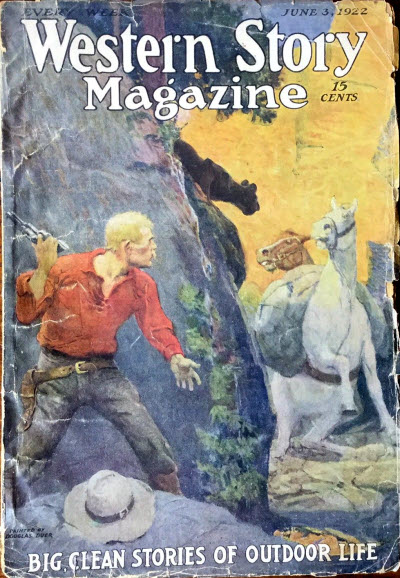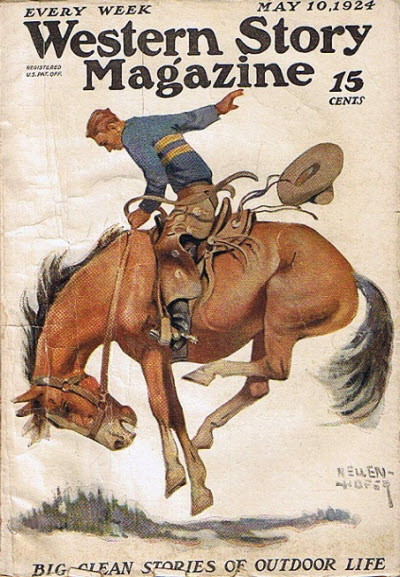Anyone interested in a thread about where modern fandom came from, and who created it?
[only 18 tweets long this time! I may be learning brevity.
[only 18 tweets long this time! I may be learning brevity.
The accepted wisdom is that Hugo Gernsback invented sf fandom in the Science Fiction League & in the pages of AMAZING STORIES, and that (per Wikipedia) “a wide variety of Western modern organized fannish subcultures originated with science fiction fandom.” LIES! ALL LIES! 1/
The reality is that sf fandom was one point in a continuum, not the starting place. Modern fandom got its start in the late 19th century dime novels, but what we think of as fandom now, in the 21st century, is really the product of a few Western pulps and their women readers. 2/
The first Western pulp was WESTERN STORY MAGAZINE, which debuted in 1919 and would eventually run for 35 years and a very impressive 1,301 issues. Before 1919 WESTERN STORY MAGAZINE was the dime novels BUFFALO BILL STORIES (1901-1912) & NEW BUFFALO BILL WEEKLY (1912-1919). 3/
What WESTERN STORY MAGAZINE (WSM) took from its dime novel incarnations was the letters page. Pulp publisher Harold Hersey described the letters “department” in pulps as “essential to the organic life of any periodical.” In WSM the letters department birthed modern fandom. 4/
WSM had two “readers’ departments:" “The Roundup,” in which readers responded to the stories in each issue of WSM with letters-of-comment—the usual sort of fan letters department; and “The Hollow Tree,” in which readers responded to and interacted with each other. 5/
“The Hollow Tree” was a community-building venture, one that (quoting Victoria Lamont) “was a key feature of print-culture expansion beginning in the late 19th century and profoundly reorganized US culture by challenging the primacy of affiliation based solely on residence.” 6/
The editors of “The Hollow Tree” encouraged readers to become “pen friends,” and to buy official WSM buttons identifying themselves as “Treeites,” members of the “Hollow Tree Gang,” so that they would recognize each other in public. 7/
What this did was create an imagined community of readers that traversed geographic distances, social distances, gender differences, and even racial differences. Via “The Hollow Tree” WSM readership was reimagined as a family—a metaphor that Treeites themselves used. 8/
This was deliberate on the part of WSM’s editors. They encouraged the readership-as-family dynamic and took pride in the fact that WSM’s readership was so diverse and all-American--“All-American” here meaning *all* Americans. Here’s a 1922 description of WSM’s letter writers: 9/
“We have a number of Hindus in the H.T. Gang, one Kongo African, a number of Japanese and Chinese, and some representatives of scattered nationalities such as Singhalese and Hawaiian and Filipino.” (Plus some Native Americans). 10/
WSM didn’t have any international distribution, although the odd copy sometimes made its way overseas. The “Hindus,” “Kongo African,” etc. were American readers who had joined the Hollow Tree Gang because they wanted to be a part of the H.T.G. family. 11/
WSM’s editors loved this and saw it as an instrument for social progress. In 1922 they wrote an editorial about how Treeites spanned every barrier there was—regional, sexual, social, racial—and that displaying the HTG button was a vehicle for breaking down those barriers. 12/
The editorial listed all the different types of people who wore the button: old, young, Italian (“but a perfectly good American” [sic]), Black, “a pretty and popular young social bud.” “Can you fancy what a leveling process & what a fraternalizing element those buttons are?” 13/
Who were the editors of The Hollow Tree? Women. Who were the majority of the letter writers to The Hollow Tree? Women. Again quoting Lamont: “These women…saw the magazine as a legitimate vehicle by which to forge bonds with a community of women.” 14/
Of course, the editors imposed certain heteronormative limits on the Hollow Tree: letters were exchanged “only between men and men, boys and boys, women and women, girls and girls.” The editors understandably didn’t want to be seen as fostering improprieties. 15/
The women of The Hollow Tree not only became pen-pals—they became friends. Some moved in with each other. Some found love with each other. And many held small and medium-sized unofficial Hollow Tree Gang gatherings—the first modern fancons. 16/
All this before 1926, when AMAZING STORIES debuted. Did Hugo Gernsback know about what the women of the Hollow Tree Gang were doing? He must have. The success of WSM’s letters departments was known industry-wide; the fancons were known to other pulp editors. 17/
The Hollow Tree Gang led to the science fiction fandom, which eventually led to other organized fandoms in the West. But modern sf fandom, and all the other fandoms, only exist because the women of Western Story Magazine and of the Hollow Tree Gang paved the way for them. 18/18

 Read on Twitter
Read on Twitter











![The editorial listed all the different types of people who wore the button: old, young, Italian (“but a perfectly good American” [sic]), Black, “a pretty and popular young social bud.” “Can you fancy what a leveling process & what a fraternalizing element those buttons are?” 13/ The editorial listed all the different types of people who wore the button: old, young, Italian (“but a perfectly good American” [sic]), Black, “a pretty and popular young social bud.” “Can you fancy what a leveling process & what a fraternalizing element those buttons are?” 13/](https://pbs.twimg.com/media/En2HyyfXUAM_rDc.jpg)






